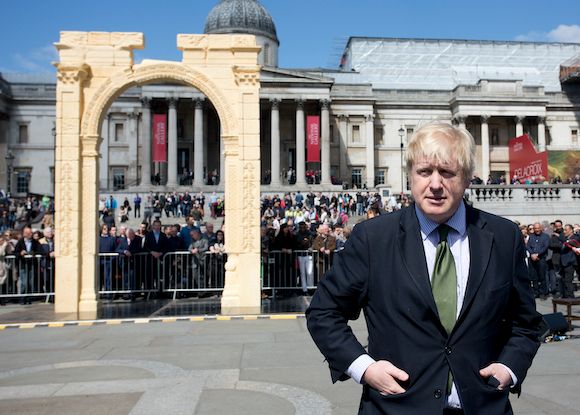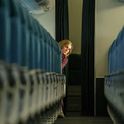Six years after he was murdered by Islamic State (IS), Khaled al-Asaad’s human remains were finally recovered on 7th February. The final days of the Syrian Director of Antiquities in Palmyra have an element of heroic mythology befitting the ancient city in which he worked. According to reports, IS tortured him to reveal where its famous funerary busts and rumoured gold treasure had been hidden. When he refused to say, he was beheaded in the city’s Roman theatre and a sign hung round his neck reading: “director of idolatry.”
Simon Schama, in the opening to the 2018 BBC reboot of Civilisations, described Palmyra’s capture by IS and Asaad’s death with customary rhetorical brio: “We can spend a lot of time debating what civilisation is or isn’t but when its opposite shows up, in all its brutality and cruelty and intolerance and lust for destruction, we know what civilisation is.”
But that wasn’t the whole story. Asaad’s son Mohammed told journalist Jeremy Bowen that the curator wasn’t killed for protecting precious artefacts, but for refusing to pledge allegiance to IS. Asaad is a hero for his defiance as a contemporary Syrian. He did in fact also defend Palmyra’s antiquities—along with Mohammed, he sent items to Damascus for safekeeping. But the Syrian government who employed him, which presents itself as a defender of the nation’s cultural heritage, cared little for what it received. Long before the IS takeover, Palmyrene objets d’art had been smuggled to Europe and ended up in London shop fronts.
Perhaps he was too embarrassed to use the word, but surely when Schama spoke of the “opposite” of civilisation he meant barbarism. It’s an old trope—marauding Barbarians sacking noble Rome and so on—as well as a lazy one. Calling IS “barbarians” might be satisfyingly vivid but it makes the militants’ atrocities part of their intrinsic nature rather than explicable, if deplorable, actions in history. It also absolves those acting in the name of civilisation from crimes they may have committed. The tragic story of Palmyra’s destruction is much more than a parable for art historians: it has its own layered backstory.
When I visited Palmyra in 2006, I found its romance intoxicating. I stayed overnight in the desert near the illuminated ruins. Along with fellow students, I ate platters of mansaf and danced all night to traditional music. (Yes, it was a bit “gap year.”) Before dawn a friend and I trudged up a hill to the Arab castle overlooking the city. After watching the sunrise, we walked under the Triumphal Arch and picked our way through the colonnaded path filled with broken carved stones. We poked round the impressive Temple of Bel, a fusion of Roman and Near Eastern styles dedicated to an eastern god in 32 AD. I spotted a carved procession scene with a group of women draped in swirling cloth that looked like a modernist sculpture. Khaled al-Asaad himself wrote an authoritative little study that illuminated where we wandered: Palmyra: History, Monuments and Museum. His rather academic description of the theatre in which he met his appalling fate—“with the two vaulted passages, called parodoi, the theatre had a middle entrance, passing under the tiered seats and leading to the circular street”—cannot now be read without a terrible sense of foreboding.
In the mid-third century AD, Palmyra’s most famous resident appeared. Zenobia was an opponent of the Romans—a kind of Eastern Boudicca. In Edward Gibbon’s classic account Zenobia, who called herself the Queen of Palmyra and undertook a doomed march to capture Rome, was “esteemed the most lovely as well as the most heroic of her sex.” She has become something of a folk hero in certain Syrian circles: Asaad named one of his daughters Zenobia.
When I saw what IS had done to Palmyra, I felt as outraged as Schama. I still do. But my view of the city had been partial to say the least. Like other western visitors, I had assumed the city had been abandoned in the desert for millennia. But as the art historian and Syria expert Stephennie Mulder argued in a 2018 lecture at the V&A, the current Palmyra site is a recent re-invention. The most magnificent thing I saw there were the tall tombs, like the stately tower that once housed the remains of Palmyrene aristocrat Marcus Ulpius Elahbelusm. But it had to be renovated by Gertrude Bell in the 1920s, and even before it was detonated by IS there was little to see inside: the haunting funerary monuments depicting Palmyra’s great and good had been taken to places like the British Museum and the Louvre.
Until the 1930s, mud-brick houses were interspersed among the temples and tombs. French archaeologists—Syria was then under the French mandate—moved the inhabitants to nearby Tadmour and destroyed the houses. Inside the Temple of Bel, Mulder pointed out, a mosque had been in continuous use for 800 years and before that a church. The mosque was deemed an unnecessary distraction and torn down by the French. (I wonder if IS knew that this pagan temple had an Islamic prayer niche?) Mulder displayed a provocative image: four top-down photos from 1929 to 2015, showing progressively fewer buildings on the temple site. Destruction at Palmyra didn’t begin with IS.
Some might call this dangerous moral relativism. Surely there is a difference between western archaeologists preserving ancient Palmyra and the ignorant bigots of IS dynamiting it? I would agree—up to a point. We should recognise the invented nature of a tourist attraction like Palmyra and ask hard questions about to what ideological use it has been put in Syria’s bloody civil war.
Since Europeans began visiting in the 18th century, Palmyra has been seen as a civilised oasis in a desert of ignorance: part of the west’s heritage that accidentally ended up on Arab soil. Such attitudes die hard. In Paul Veyne’s Palmyra: An Irreplaceable Treasure (2015), the French archaeologist quotes rock graffito left by a Roman soldier: “Syrians are a nasty breed, a kakon genos.” But the people of Palmyra, Veyne protests, were a better breed: “Palmyra was not a Syrian city like others,” he says, it was more like Venice. Later, he writes that IS’s actions were really an attack on “contemporary westerners, whose culture includes an educated love for ‘historical monuments’ and a great curiosity for the beliefs of other people and other times.” Syrian victims are elided: what matters most is the threat to Enlightenment values.
So why did IS blow up temples and vandalise the faces on stone reliefs? This was clearly a symbolic as well as physical attack—but of what kind?
For many Syrians, the site was notorious for the nearby Tadmour prison (originally built by the French) where dissidents including Islamists were tortured by the long-term dictator Hafez al-Assad. In 1980, perhaps 1,000 prisoners were summarily shot after a failed assassination attempt on the president and their bodies dumped outside the gates. Soon after his son Bashar assumed power in 2000, he closed the prison as a gesture of openness. But when the revolution began 10 years later, he began filling it once more. When IS fighters arrived, they released the prisoners and blew up the prison—a moment like the storming of the Bastille.
There were religious motivations as well. Before it got to the pagan temples, IS destroyed two Muslim shrines—one Sufi, one Shia—on nearby hilltops. The defacement of statues in the Palmyra museum was an extension of Sunni IS’s sectarian hatred of “idolatry.” Interestingly, IS preferred to utilise Palmyra’s more “Roman” spaces. In a gruesome spectacle, Syrian soldiers as well as civilians like Asaad were publicly executed in the theatre I had once walked round. It was almost as though the militants were echoing the theatrical Roman violence you see enacted in popular culture: I bet many IS supporters love Gladiator.
But the most likely reason Palmyra was targeted was because it had become so closely associated with Bashar al-Assad’s Baathist regime. Since the 19th century, Zenobia and her city had become a symbol of Arab resistance to the Ottomans. After independence in 1946, she became a poster girl for secular Arab nationalism: Syrian TV broadcast a series about her in the 1970s and she also appeared, alongside the famous Triumphal Arch, on a Syrian banknote. In the mid-1980s, a biography of Zenobia was published by General Mustafa Tlass, long-serving defence minister of Hafez al-Assad. For IS, a desire to efface any traces of a non-Islamic past melded with a hatred for the Assads’ militaristic propaganda.
After Syrian government forces chased out IS with Russian help, Bashar al-Assad’s propaganda machine went into overdrive. In May 2016, a concert led by Vladimir Putin’s favourite conductor, Valery Gergiev, was held in the Roman theatre. During the closing speech there were cheers when the names of Syria’s great cities were read out, including Aleppo. But the brutal Russian-backed bombardment of Aleppo had already begun and the city was destroyed by the year’s end. As well as many civilian lives, that battle obliterated the old souk and countless ancient treasures.

Meanwhile a similar saviour narrative was developing in London. In April 2016, a replica of Palmyra’s Triumphal Arch was unveiled in Trafalgar Square by mayor Boris Johnson. A keen amateur classicist, Johnson told the crowd that this gesture was “in defiance of the barbarians.” Photos of the event frame the Arch in front of the neo-classical façade of the National Gallery. The Syrian government was continuing to bomb its own people at this time, making the exhibit in especially poor taste.
Cultural heritage is important: it gives people an identity, quite apart from its historical and aesthetic value. But I wonder whether a better object to represent Syria would have been the 11th-century minaret at Aleppo’s Umayyad mosque, which was destroyed in 2013 in the crossfire between government troops and rebels—an object of equal cultural importance as Palmyra’s Triumphal Arch. But somehow I couldn’t see Johnson unveiling a replica minaret in the middle of London.
Walter Benjamin wrote that “there is no document of civilisation which is not at the same time a document of barbarism.” Palmyra is a wonderful site that should be preserved for future generations of Syrians. But the rhetoric of “saving civilisation” obscures the crimes that were committed in its saving. In the course of fighting IS, the Syrian city of Raqqa, 220km north of Palmyra, faced relentless US and UK bombing. As with the destruction of Dresden in the Second World War, you could argue this was a necessary evil to defeat a dangerous enemy. But we should acknowledge the evil done.
Another of Khaled al-Asaad’s sons, Tareq, has said he wants his father buried in the garden of Palmyra’s museum, an appropriate resting place for a man who loved the city, and knew it better than anyone. If I ever have the chance to return, I’d hope to visit what would be the latest of Palmyra’s significant tombs. It is another layer of history added to an extraordinary place—one that deserves more than to be co-opted in a crude battle between the forces of “civilisation” and its opposite.












